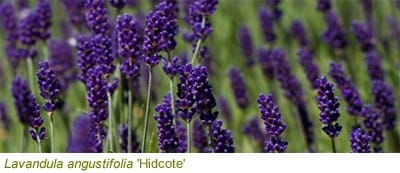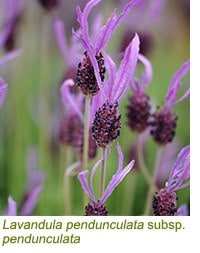Lavenders - aromatic sun-lovers
Aromatic plants produce their own fragrant oil and they use it as a sunscreen to prevent scorching, so anything aromatic or silvery needs full sun. Although drought-tolerant, these plants rely on a deep root system and once established they will never need watering, or feeding. When you plant a silver or aromatic plant however, it must be coached through its first season, so water it regularly. After that it will put down fine roots that go down for two or three feet and you need never water again.

The quintessential aromatic is lavender and there are three basic types on offer. English lavender (Lavandula angustifolia) is the hardiest of all and it produces low-growing plants with fine foliage topped by summer flowers that are held on short stems, just above the leaves. It's compact enough for the front of the border, or train it as a low hedge. Good forms include the deep blue 'Hidcote', the highly regarded blue 'Little Lady' and the lilac 'Munstead'.
 If you wish to dry the flowers pick them early, usually in the last week of Wimbledon. Pruning isn't a problem, so this type of lavender should be cut back every August so that it reshoots and overwinters. Treated like this it will live for twenty-five years. It can also be given a Chelsea chop, reduced by a third in May, to produce flowers that appear later and follow the main flush of roses.
If you wish to dry the flowers pick them early, usually in the last week of Wimbledon. Pruning isn't a problem, so this type of lavender should be cut back every August so that it reshoots and overwinters. Treated like this it will live for twenty-five years. It can also be given a Chelsea chop, reduced by a third in May, to produce flowers that appear later and follow the main flush of roses.
The second is known as a lavendin and this hybrid flowers in late summer producing billowing foliage and long stems topped with tapering slender flowers. Named L. x intermedia, these make good statement plants but they are not as hardy. Round the plants off every autumn, when flowering becomes ragged, but never cut them back into old wood. This autumn trim produces rounded plants that have good winter presence. 'Grosso' is the form grown all around Provence, for oil production, but the foliage is a fresh-green rather than grey. The purple flowers splay outwards from the foliage.
 Finally the tufted lavenders, with petals that stick out of the top, are the least hardy so they only tolerate being lightly trimmed in May or June, after their first flush of flower. Good forms include the burgundy and purple 'Helmsdale' and the pink-tufted 'Rocky Road'. The most elegant is Spanish lavender, Lavandula pedunculata subsp. pedunculata, with very long waving petals that constantly shimmy and sway in the slightest breeze.
Finally the tufted lavenders, with petals that stick out of the top, are the least hardy so they only tolerate being lightly trimmed in May or June, after their first flush of flower. Good forms include the burgundy and purple 'Helmsdale' and the pink-tufted 'Rocky Road'. The most elegant is Spanish lavender, Lavandula pedunculata subsp. pedunculata, with very long waving petals that constantly shimmy and sway in the slightest breeze.






